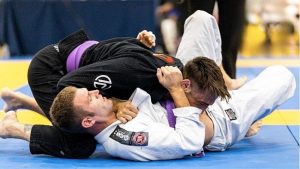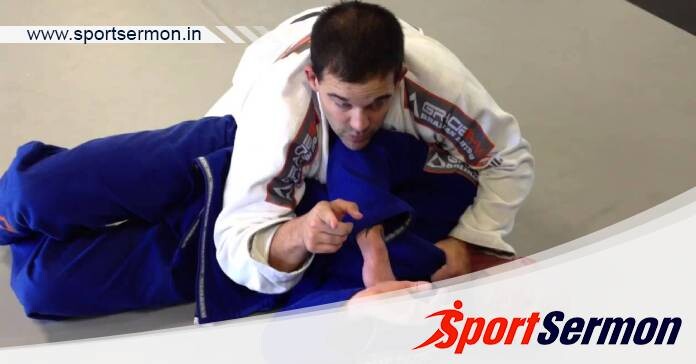The grappling and submission hold on the ground are extensively emphasised in the martial art of Brazilian Jiu-Jitsu (BJJ). It’s a physical exercise that also requires technological know-how and strategic consideration. A simple and effective submission that may be used in both training and competition, the paper cutter choke is one of the many BJJ techniques. This essay will explain the setup, application, common mistakes, and counters of the BJJ paper cutter choke in great detail.
Learning About The Paper Cutter Choke
A submission move that concentrates pressure on the opponent’s neck is called the “paper cutter choke,” sometimes referred to as the “bread cutter choke” or the “cross choke.” The term refers to the motion, where one arm presses on the neck while the other pulls in the opposite way, which mimics the cutting motion of a paper cutter. The strategic component of BJJ, where leverage and skill may prevail over sheer power, is demonstrated by this choke.
Chokes And Their Relevance In BJJ

It is crucial to know how chokes function in BJJ before delving into the mechanics of the paper cutter choke. If a choke, a sort of submission that decreases blood supply to the brain, is not removed, it might cause unconsciousness. They are an essential component of BJJ and are typically preferred over joint locks since they can be practised with safety and without endangering others.
You might also be interested in reading this: A Complete Guide On BJJ Bulldog Choke
Putting The Cutter Choke in Place
Usually, the side control or knee on the belly positions are used to set up the paper cutter choke. With one arm firmly under the opponent’s head and an overhand grasp on the collar, the practitioner secures the position. The base of the choke is formed by this grip, making it essential. The opposing hand slides under the adversary’s arm and grabs the other side of the collar with the palm facing down. The ‘cutting’ component of the choke is done using this grip.
Blackbelt in BJJ In this video, Jeff Glover describes the method’s workings. You’ll see that there aren’t many stages involved in carrying it out. As you dominate the opponent, go to the side and grasp the opponent’s collar while sliding your arm over the opponent’s neck. Bypassing the defensive hand is the key to using this strategy. As the opponent would try anything to avoid being tapped, we advise you to be patient.
The Choke’s Mechanism
The effectiveness of the paper cutter choke is due to the combination of pushing and pulling forces. The collar is tightened and the region around the neck is constricted by pulling it with the hand below the head. The neck is concurrently compressed downward by the second hand. Both of these processes result in less blood flowing to the brain, which makes the subject submit.
The paper cutter choke’s main goal is to prevent the opponent from opening their airway but depending on the angle, it can also lead to a blood choke. Pushing the tap requires little effort once a solid bite on the neck has been established using the right technique.
Typical Errors And Things To Think About
A common mistake is not applying the paper cutter choke with a tight enough grip on the collar. A weaker grip reduces the effectiveness of the choke and makes it easier for the opponent to defend. Make sure your fingers are as far back in your grasp as possible to correct this.
Another error is not exerting enough forearm pressure. Some practitioners disregard the significance of the downward pressure in favour of putting too much emphasis on the pulling action. Keep in mind that the combination of the two acts results in the choke.
Rushing the choke is a third typical error. The paper cutter choke needs perseverance, just like every other BJJ move. Rushing the choke might result in improper placement or grip, which could let your opponent escape. Before applying the choke, take your time to make sure your grips and posture are solid.
Protecting Oneself From The Paper Cutter Choke

Understanding the setup and responding swiftly are necessary to defend against the paper cutter choke. It’s critical to interfere with an opponent’s setup if they manage to get a hold of your collar. You may do this by releasing the hold or shifting your position.
Another protective tactic is to tuck your chin in and use your hands to guard your neck. This might give you some extra time to get away or change your position.
Additionally, it’s critical to keep in mind the BJJ tenet that “position comes before submission.” You can avoid the choke altogether if you maintain a decent stance and keep your adversary from taking control of the situation.
The Paper Cutter Choke: Including It In Your Game
The paper cutter choke is a flexible tactic that may be used in a number of different methods. It can be applied as a stand-alone technique or as a direct strike. As an illustration, if an opponent fights against a choke, they could leave themselves open to arm locks or other submissions.
The paper cutter choke is one technique that might help you become more proficient in BJJ. Your comprehension of grips, body alignment, and the idea of pressure may improve as a result. It can also educate you to be patient and to hold off on applying for submission till the proper time.
Any BJJ practitioner’s toolbox should include the paper cutter choke. Effective execution necessitates accuracy, timing, and mechanical knowledge. To perfect it, as with every BJJ technique, practice is necessary. Consider practising your paper cutter choke the next time you’re on the mats because it may be the game-changer you’ve been seeking.
Always keep in mind that learning new BJJ techniques is like progressing along a trip. There’s always something new to learn and get better at, whether you’re a black belt with decades of experience or a white belt just getting started. As a result, continue your training, education, and improvement. The reward is in the journey.
This is a condensed description of the paper cutter choke, so please be aware of it. It takes months of practice and hands-on training to master a skill. To guarantee safety and efficacy, always remember to practise grappling methods under the guidance of a certified teacher.

